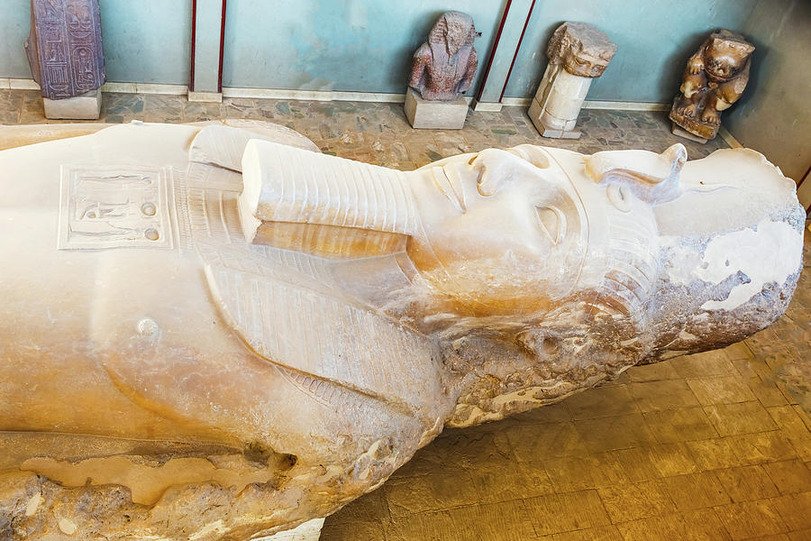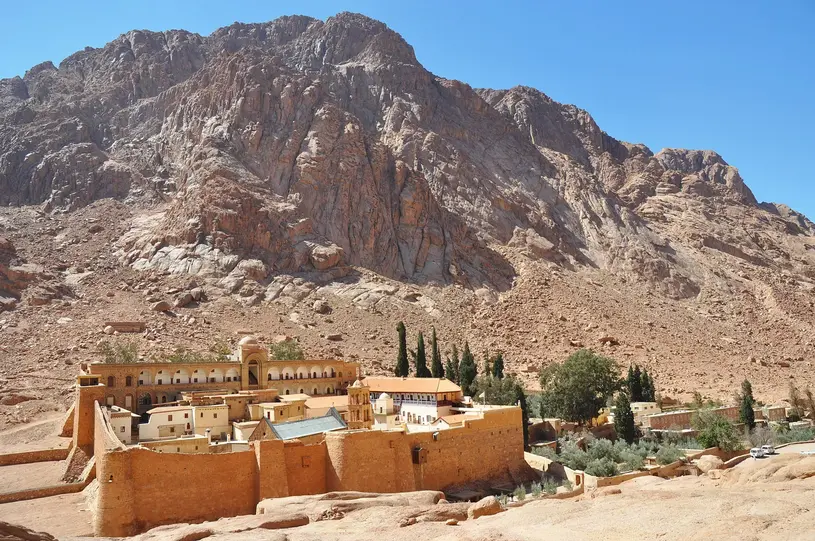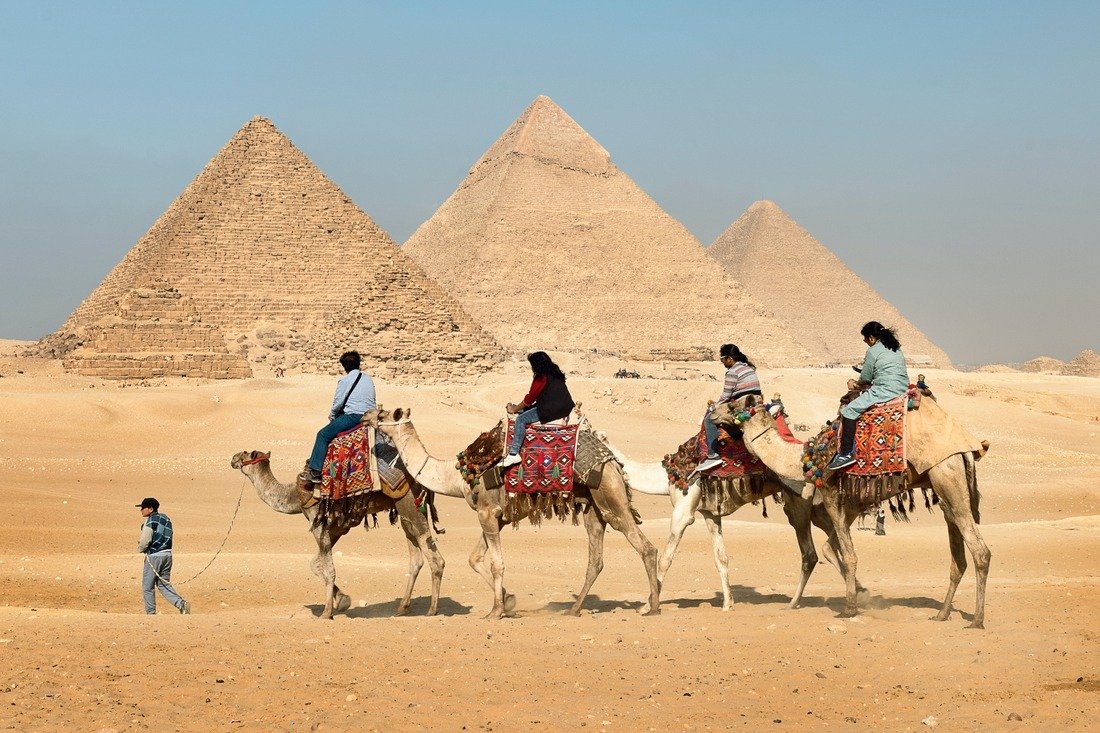Embark on a captivating journey through the treasures of Egypt’s rich history. Be amazed by the majestic Great Pyramid of Giza and the enigmatic Sphinx. Delve into the ancient wonders of Luxor Temple, Karnak Temple, and the Valley of the Kings. Experience the enchanting allure of Siwa Oasis and the awe-inspiring sights of Sakkara. Witness the splendor of the Mortuary Temple of Hatshepsut and the mystical St. Catherine’s Monastery. Admire the grandeur of the Citadel of Qaitbay and marvel at the architectural brilliance displayed by the Red and Bent Pyramids. From the magnificent statues of Ramesses II to the tranquil beauty of Siwa Oasis, Egypt’s historical tapestry invites you to uncover its remarkable wonders.
Great Pyramid of Giza

19 Best Historical places to visit in Egypt. The Great Pyramid of Giza, located in the Giza Governorate of Egypt, is considered one of the most popular tourist destinations in the country. It holds a significant place among the Seven Wonders of the Ancient World, being the only one to have withstood the test of time. Out of the three captivating pyramids in the Giza pyramid complex, the Great Pyramid of Giza stands as the largest and oldest.
According to Egyptologists, this pyramid serves as the final resting place of Pharaoh Khufu from the Fourth Dynasty of Egypt. Remarkably, it held the title of the world’s tallest man-made structure for an astonishing 3,800 years.
Luxor Temple

Erected primarily during the reigns of Pharaohs Ramses II (1279–1213 BC) and Amenhotep III (1390–1352 BC), the Luxor Temple stands as a testament to the grandeur of ancient Egyptian architecture. This imposing structure, often referred to as the Southern Sanctuary, has undergone significant modifications throughout history, including interventions by King Tutankhamun, the Romans, and Alexander the Great.
Recognized as a UNESCO World Heritage Site, the Luxor Temple boasts not only historical significance but also remarkable aesthetic features. The intricate sandstone walls, adorned with elaborate carvings and hieroglyphics, take on a mesmerizing glow, particularly enchanting as the sun sets over the ancient city of Luxor. This interplay of light and stone adds a captivating dimension to the already impressive archaeological site, inviting visitors to delve into the rich tapestry of Egypt’s cultural and historical legacy.
Valley of the Kings

Nestled along the picturesque western bank of the Nile and historically designated as the Place of Truth or the Great Necropolis of Millions of Years of Pharaoh, the Valley of the Kings holds a profound significance as the primary burial ground for Pharaohs dating from the 11th to the 16th century BC.
This awe-inspiring necropolis comprises over 63 chambers and tombs, each a testament to the intricate artistry and cultural richness of ancient Egypt. The walls of these tombs are adorned with a myriad of captivating artworks, intricately depicting scenes from Egyptian mythology, religious rituals, and the Pharaohs’ journey to the afterlife. From detailed hieroglyphics to vibrant murals, the Valley of the Kings offers a captivating glimpse into the beliefs and customs of this ancient civilization.
Siwa Oasis

Situated in the western expanse of Egypt, far removed from the urban clamor, Siwa Oasis emerges as a haven of tranquility and natural beauty. Embraced by lofty date palms and cradled by numerous scenic water springs, this enchanting oasis stands out as one of the most serene destinations in Egypt, particularly within the Western Desert.
The landscape is graced by the remnants of a splendid mud-brick fortification, adding an ancient allure to the surroundings. Siwa Oasis, with its captivating ambiance, serves as an idyllic retreat, offering respite from the hustle and bustle of city life. Beyond its peaceful charm, the oasis serves as an excellent launchpad for adventurous excursions into the expansive surrounding desert, making it an ideal base for those seeking exploration and immersion in the mesmerizing wilderness.
Sakkara Pyramids

While the Pyramids of Giza are renowned worldwide, Egypt unveils an array of majestic pyramids that might just surprise you. A short distance from Cairo city, the Sakkara Pyramids beckon, providing a glimpse into the architectural prowess that thrived among ancient Egyptians.
Comprising the Red Pyramid, Bent Pyramid, and Step Pyramid, the Sakkara Pyramids form a captivating ensemble that stands proudly, a testament to the ingenuity of the bygone era. These structures not only offer a visual feast for the eyes but also serve as windows into Egypt’s rich history. Adjacent to the pyramids, you’ll discover ancient tombs adorned with intricately detailed interior walls, each narrating a story of the past and adding to the allure of this historical site.
Great Sphinx of Giza

With the countenance of a human and the body of a lion, the towering 66 feet tall Great Sphinx of Giza commands attention on the western bank of the Nile River. Crafted from limestone, this enigmatic figure holds the distinction of being Egypt’s oldest known monument.
Despite the passage of time, the original age and purpose of the Sphinx remain shrouded in mystery, adding an air of intrigue to its colossal presence. For history and mythology enthusiasts, the Great Sphinx of Giza stands as an unparalleled destination, inviting exploration and contemplation of the ancient riddles that surround its existence.
Karnak Temple

Located in El-Karnak, Luxor, Luxor Governorate, Egypt, the Karnak Temple is widely regarded as one of Egypt’s most prominent historical tourist destinations. This expansive complex is home to numerous remarkable structures, including the Temple of Khons, the Festival Temple of Tuthmosis III, and the magnificent Great Temple of Amun.
Within the boundaries of this renowned temple, visitors are treated to the renowned Konark Open Air Museum, which serves as a testament to the exceptional craftsmanship of ancient times. Additionally, the site showcases a variety of ancient pylons, chapels, and remnants of weathered temples, each carrying the echoes of long-gone eras. It is worth noting that the Karnak Temple holds the distinction of being the second-largest ancient spiritual site in the world, further enhancing its historical allure and significance.
Temple of Medinat Habu

The Temple of Medinat Habu, also referred to as the “Mortuary Temple of Ramses III,” is a well-known religious site situated in Luxor City, Egypt. Despite King Ramses III being buried in the Valley of Kings, the construction of Medinet Habu was specifically dedicated to honoring his enduring legacy.
To fully appreciate the grandeur of the entire complex, the southeast corner of this monumental structure offers an optimal viewpoint. Within the Medinet Habu, visitors can explore various remarkable attractions such as the Chapels of the Votaresses, the Second Pylon, the Sacred Lake, the First Pylon, the Nilometer, and the awe-inspiring Hypostyle Hall.
Statue of Ramesses II

The Statue of Ramesses II, which dates back 3,200 years, depicts the king in a commanding upright position. Made from red granite, this massive statue stands at a height of 11 meters and was discovered by Giovanni Battista Caviglia in 1820 at the Great Temple of Ptah.
Originally found in several pieces, the statue underwent careful restoration work over time, eventually regaining its original towering stature. Currently exhibited on a three-meter pedestal at the Grand Egyptian Museum, the Statue of Ramesses II weighs around 7.25 tons, making it one of Egypt’s most monumental and awe-inspiring sculptures. It serves as a testament to the magnificence of ancient Egyptian artistry and craftsmanship.
Pyramid of Khafre

The Pyramid of Khafre, one of the three Pyramids of Giza, is considered the second largest and second tallest. It was built as a burial monument for Pharaoh Khafre during the Fourth Dynasty, ruling from 2558 to 2532 BC. With a base spanning 215 meters and reaching a height of 136 meters, this magnificent pyramid is adorned with a layer of Tura limestone. Inside the pyramid, there are fascinating chambers intricately carved from limestone.
Notably, the Pyramid of Khafre features two entrances—one at ground level and another positioned 11 meters above, adding an intriguing architectural element to this ancient wonder. Situated in Al Haram, Giza Governorate, Egypt, the Pyramid of Khafre stands as a testament to the grandeur and craftsmanship of the ancient Egyptians.
Red and Bent Pyramid

The Bent Pyramid, an early pyramid in Egypt, serves as a testament to the brilliance of Sneferu, a prominent figure in the Pharaonic lineage. Unlike later pyramids, this remarkable architectural marvel, also known as the Red Bent Pyramid of Dahshur, possesses a distinct design that sets it apart.
Featuring three funeral chambers, the third chamber of this pyramid showcases an exceptionally uncommon element. The roof, constructed with red stones, is skillfully crafted with gradual overhangs, forming a unique pattern that cannot be found in any other pyramids. This distinctive characteristic enhances the allure of the Bent Pyramid, establishing it as a pioneering and unconventional masterpiece in the realm of ancient Egyptian architecture.
Pyramid of Djoser

Regarded as one of the lesser-explored treasures in Egypt, the Pyramid of Djoser provides a unique opportunity to experience an Egyptian pyramid without the usual crowds. Nestled south of Cairo in Saqqara town, the Djoser Pyramid stands as one of the oldest stone-cut monuments on Earth.
Dating back to the 27th century BC, this pyramid distinguishes itself with a distinctive step-style architectural design, predating the smoother-sided architecture of the more renowned Pyramids of Giza. Offering a glimpse into ancient Egyptian ingenuity and craftsmanship, the Pyramid of Djoser is a captivating destination for those seeking a quieter exploration of Egypt’s rich archaeological heritage.
Mortuary Temple of Hatshepsut – Deir el-Bahari

Situated on the western banks of the River Nile, at the base of the Libyan plateau, lies the magnificent Mortuary Temple of Hatshepsut. This temple serves as a majestic tribute to the sun god, Amon-Ra. Constructed using limestone, the temple showcases a timeless allure with its classical architectural design.
The Mortuary Temple was commissioned to honor the extraordinary achievements of Queen Hatshepsut and was skillfully crafted by the renowned architect of its time, Senimut. Spanning across three impressive terraces, the temple encompasses a hypostyle hall, courts, and pylons, all contributing to its grandeur and historical significance.
The Mortuary Temple of Hatshepsut can be found in the New Valley Governorate of Egypt, under the jurisdiction of the Egyptian Environmental Affairs Agency.
Valley of Artisans

The Valley of Artisans, also referred to as Dier el-Medina, is a renowned attraction in Egypt that offers an exceptional opportunity to explore the iconic Egyptian tombs. Positioned on the western side of the River Nile, in close proximity to the Colossi of Memnon and Medinet Habu, this site presents exquisitely crafted dwellings of workers and impeccably illustrated tombs.
Within the Valley of Artisans, visitors can marvel at the captivating tombs of Shuroy, Roy, Anker Ka, and Sennutem, which showcase a mesmerizing array of vibrant colors and scenes depicting daily life. The convenient proximity of these tombs enables visitors to seamlessly delve into the rich historical and artistic heritage of ancient Egypt within this enchanting valley.
Avenue of Sphinxes

The Avenue of Sphinxes, positioned between the Luxor Temple and the Karnak Temple complex, holds great historical significance as a pathway where numerous commercial processions took place in the past. Dating back to 380 BC, this avenue stretches across approximately 2.7 kilometers and is adorned with a total of 1,350 sphinxes.
While the Great Sphinx at Giza is the most famous among these mythical creatures, distinguished by its feline characteristics, the other sphinxes that line the Avenue of Sphinxes feature unique ram heads. This magnificent route stands as a testament to the grandeur and ceremonial traditions of ancient Egypt, providing visitors with a captivating glimpse into the cultural and historical richness of Luxor City.
Colossi of Memnon

The Colossi of Memnon, situated in Al Bairat, Luxor, Luxor Governorate, Egypt, are renowned historical landmarks that attract numerous tourists. These impressive statues, which were once protectors of King Amenhotep III’s temple, are made of quartz sandstone and reach a towering height of 59 feet. Weighing a combined total of around 700 tons, they showcase the king’s likeness with great skill and artistry.
The statues are adorned with intricate carvings near their legs, representing the mother and wife of King Amenhotep III. Despite some damage to their faces over time, the Colossi of Memnon continue to mesmerize visitors with their sheer size, serving as a testament to the magnificence of ancient Egyptian craftsmanship and the historical importance of Luxor.
Temple of Seti

Situated on the outskirts of the city of Luxor, the Temple of Seti is a hidden gem among Egypt’s attractions, often overlooked by visitors. Named after Seti I, the Egyptian ruler who initiated its construction, the temple remains incomplete.
Despite some damage over time, the Temple of Seti preserves its allure, with walls adorned by beautiful carvings depicting Seti I, Ramses II, and various gods. This less-explored temple offers a unique opportunity for those seeking a quieter, yet culturally rich, experience in the historical landscape of Luxor.
Citadel of Qaitbay or The Fort of Qaitbay

Situated on the Mediterranean Sea shoreline, the Citadel of Qaitbay emerges as an imposing stronghold built during the 15th century for defensive intentions. Constructed by Mamluk sultan Qaitbey on the remains of the renowned Pharos lighthouse, this citadel exhibits resilient architecture and robust walls. Transformed into a maritime museum in 1952, this historical fortress not only grants a glimpse into Egypt’s opulent architectural and historical heritage but also showcases an exceptional assortment of fossilized marine creatures. With its advantageous position and cultural significance, the Citadel of Qaitbay offers visitors a captivating fusion of military history and marine exploration. Address: As Sayalah Sharq, Qesm Al Gomrok, Alexandria Governorate, Egypt.
St. Catherine’s Monastery is one of the 19 Best Historical places to visit in Egypt

Built between 527 and 565 AD, St. Catherine’s Monastery stands as one of Egypt’s oldest spiritual sanctuaries. Tucked at the foothills of Mount Sinai, this monastery derives its name from St. Catherine, a Christian martyr who endured persecution and martyrdom for her faith.
Nestled in the desert, the monastery boasts a remarkable collection of spiritual iconography, manuscripts, and art, including the iconic burning bush. St. Catherine’s Monastery provides a serene backdrop for those seeking spiritual reflection. Visitors also have the opportunity to ascend Mount Sinai, where breathtaking views of sunset or sunrise add to the profound experience after paying homage at this historic and sacred site.





